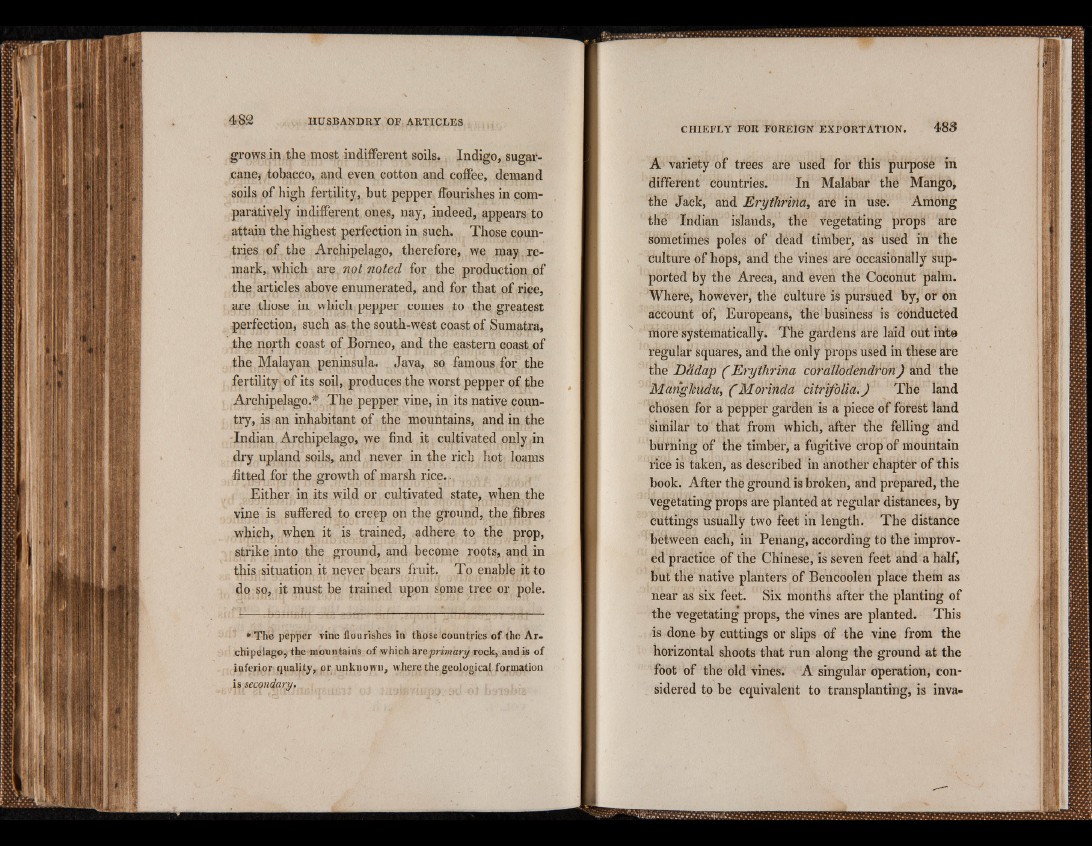
grows in the most indifferent soils. Indigo, sugarcane*
tobacco, and even cotton and coffee, demand
soils of high fertility, but pepper flourishes in comparatively
indifferent, ones, nay, indeed, appears to
attain the highest perfection in such. Those countries
of. the Archipelago, therefore, we may remark,
which are not noted for the production of
the articles above enumerated, and for that of rice,
are those in which pepper comes to the greatest
perfection, such as the south-west coast of Sumatra,
the north coast of Borneo, and the eastern coast of
the Malayan peninsula. Java, so famous for the
fertility of its soil, produces the worst pepper of the
Archipelago.* The pepper vine, in its native country,
is an inhabitant of the mountains, and in the
Indian Archipelago, we find it cultivated only .in
dry upland soils,, and never in the rich hot loams
fitted for the growth of marsh rice..
Either in its wild or cultivated state, when the
vine is suffered to creep on the ground, the fibres
which, when it is trained, adhere to the prop,
strike into the ground, and become roots, and in
this.,situation it never bears fruit. To enable it to
do so, it must be trained upon some tree or pole.
* The pepper vine flourishes in those countries of the Archipelago,
the mountains of which ¿re primary rock, and is of
inferior quality, or unknown, where the geological formation
is secondary. .
A variety of trees are used for this purpose in
different countries. In Malabar the Mango,
the Jack, and Erythrina, aré in use. Among
the Indian islands, the vegetating props are
sometimes poles of dead timber, as used in the
culture of hops, and the vines are occasionally supported
by the Areca, and even the Coconut palm.
Where, however, thé culture is pursued by, or on
account of, Europeans, the business is conducted
iriore systematically. The gardens are laid out into
regular squares, and the only props used in thèse are
the Dâdap ( Erythrina córatlodendf'OnJ and the
Mangkudu, ( Morinda citrvfolia.) The land
chosen for a pepper garden is a piece of forest land
similar to that from which, after the felling and
burning of the timber, a fugitive crop of mountain
ricé is taken, as described in another chapter of this
book. After the ground is broken, and prepared, the
vegetating props are planted at regular distances, by
Cuttings usually two feet in length. The distance
between each, in Pefiang, according to the improved
practice of the Chinese, is seven feet and a half,
but the native planters of Bencoolen place them as
near as six feet. Six months after the planting of
the vegetating props, the vines are planted. This
is done by cuttings or slips of the vine from the
horizontal shoots that run along the ground at the
foot of the old vines. A singular operation, considered
to be equivalent to transplanting, is inva